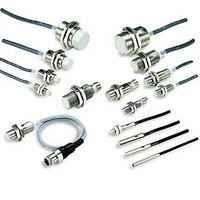E2E-X5Y2 Omron, E2E-X5Y2 Datasheet - Page 15

E2E-X5Y2
Manufacturer Part Number
E2E-X5Y2
Description
Proximity Sensors PROX M18 5MM NC (COO)
Manufacturer
Omron
Series
E2Er
Datasheet
1.E2E-X10Y1-53-US.pdf
(16 pages)
Specifications of E2E-X5Y2
Maximum Operating Temperature
+ 85 C
Mounting Style
Panel
Sensing Distance
5 mm
Minimum Operating Temperature
- 40 C
Features
NC
Sensor Type
Inductive
Sensing Object
Metallic
Response Frequency
25Hz
Material - Body
Nickel-Plated Brass
Shielding
Shielded
Voltage - Supply
20 VAC ~ 264 VAC
Output Type
SCR-NC
Terminal Type
2-Wire
Package / Case
Cylinder, Threaded - M18
Lead Free Status / Rohs Status
Lead free / RoHS Compliant
Other names
E2EX5Y2Q
J CONNECTING LOAD TO AC 2-WIRE
Refer to the following before using AC or DC 2-wire Proximity Sen-
sors.
Surge Protection
Although the Proximity Sensor has a surge absorption circuit, if
there is any machine that has a large surge current (e.g., a motor or
welding machine) near the Proximity Sensor, connect a surge ab-
sorber to the machine.
Leakage Current
When it is OFF, the Proximity Sensor has leakage current. Refer to
Leakage Current Characteristics. In this case, the load is imposed
with a small voltage and the load may not be reset. Before using the
Proximity Sensor, make sure that this voltage is less than the load
reset voltage. The AC 2-wire Proximity Sensor cannot be con-
nected to any card-lift-off relay (e.g., the G2A) because contact
vibration of the relay will be caused by the leakage current and the
life of the relay will be shortened.
Countermeasures Against Leakage Current
AC 2-wire Models
Connect a bleeder resistor as the bypass for the leakage current so
that the current flowing into the load will be less than the load reset
current.
J PRECAUTIONS FOR AC 2-WIRE PROXIMITY SENSORS IN OPERATION
Connector
E2E 2-WIRE AC
Model
AC
2-wire
SENSOR
Connection type
AND
(serial connection)
Method
Incorrect
Correct
Load
Load
Load
16
As shown in the following diagram, connect the bleeder resistor so
that the current flowing into the Proximity Sensor will be 10 mA mini-
mum and the residual voltage imposed on the load will be less than
the load reset voltage.
Refer to the following to calculate the bleeder resistance and the al-
lowable power of the bleeder resistor.
R ≦ V
P > V
P: The allowable power of the bleeder resistor. (The actual power
I:
The following resistors are recommended.
100 VAC (supply voltage): A resistor with a resistance of 10 kΩ max-
imum and an allowable power of 3 W minimum
200 VAC (supply voltage): A resistor with a resistance of 20 kΩ max-
imum and an allowable power of 10 W minimum
If these resistors generate excessive heat, use a resistor with a re-
sistance of 10 kΩ maximum and an allowable power of 5 W mini-
mum at 100 VAC and a resistor with a resistance of 20 kΩ maximum
and an allowable power of 10 W minimum at 200 VAC instead.
capacity of the bleeder resistor must be at least a few times as
large as the allowable power of the bleeder resistor.)
Load current (mA)
V
s
S
≧ 100 V
S
2
/(10 - - I) (kΩ)
/R (mW)
Description
If 100 or 200 VAC is imposed on the Proximity
Sensors, V
load) will be obtained from the following.
V
Sensors) (V)
Therefore, if V
voltage, the load will not operate.
A maximum of three Proximity Sensors can be
connected in series provided that the supply
voltage is 100 V minimum.
L
Bleeder resistor R
= V
S
Load
- - (residual voltage x no. of Proximity
L
(i.e., the voltage imposed on the
L
is lower than the load operating
VAC power
supply V
E2E 2-WIRE AC
S










